Evolution of Management Practices: A Historical Overview and Analysis
VerifiedAdded on 2022/11/29
|9
|2420
|354
Essay
AI Summary
This essay provides a comprehensive overview of the evolution of management theories and practices. It begins by examining management practices before the Industrial Revolution, focusing on craftsmanship, the decline of craft guilds, the rise of profit-making, and the resulting conflicts between workers and factory owners. The essay then delves into management practices during the Industrial Revolution, highlighting the classical theories of management, including the contributions of Frederick Taylor, Henry Fayol, and Max Weber. The essay also addresses the contributions of the Gilbreths, and Emerson. Finally, the essay explores the neoclassical theories of management that emerged after the Industrial Revolution, including human relations theory, systems theory, Maslow's hierarchy of needs, Herzberg's two-factor theory, the contingency approach, and Likert's management approach. The essay concludes by summarizing the key developments and contributions in the evolution of management, emphasizing the shift from a focus on efficiency and control to a more human-centered approach.

Evolution of
Management and
practises.
Management and
practises.
Paraphrase This Document
Need a fresh take? Get an instant paraphrase of this document with our AI Paraphraser
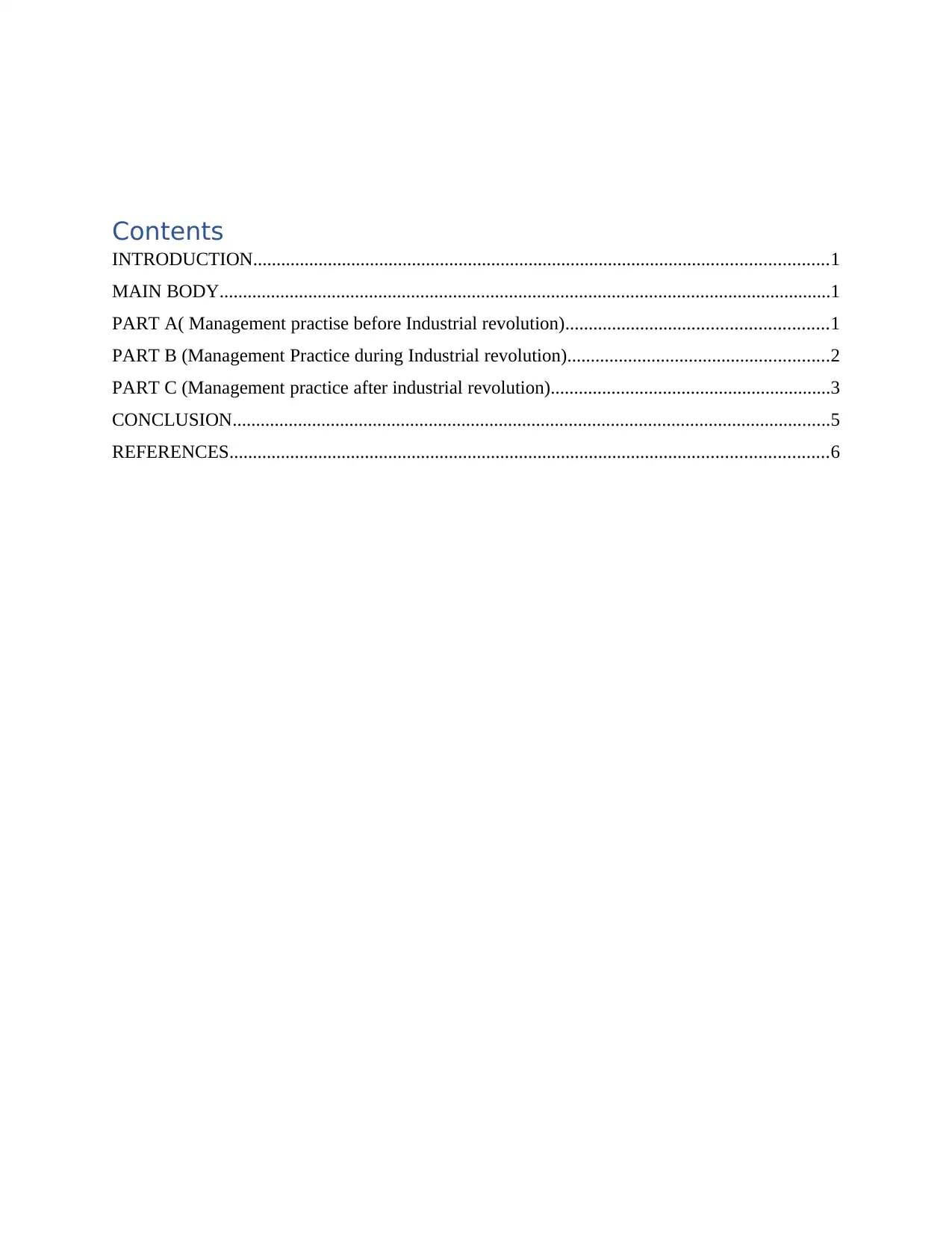
Contents
INTRODUCTION...........................................................................................................................1
MAIN BODY...................................................................................................................................1
PART A( Management practise before Industrial revolution)........................................................1
PART B (Management Practice during Industrial revolution)........................................................2
PART C (Management practice after industrial revolution)............................................................3
CONCLUSION................................................................................................................................5
REFERENCES................................................................................................................................6
INTRODUCTION...........................................................................................................................1
MAIN BODY...................................................................................................................................1
PART A( Management practise before Industrial revolution)........................................................1
PART B (Management Practice during Industrial revolution)........................................................2
PART C (Management practice after industrial revolution)............................................................3
CONCLUSION................................................................................................................................5
REFERENCES................................................................................................................................6

INTRODUCTION
Evolution of Management is thought process which is just started early days of men the
beginning of Management since the period man saw the need within leaving groups (Valero,.,
2021). In this concept of management is well known that is a process of implementing planning
control the task through planning organising directing staffing and controlling. As per following
essay report that topics are involved within three parts where part is elaborate about
management practices before industrial revolution. About management practices during
Industrial Revolution in which classical theory of Management and its contribution to be
highlighted. Part c device that measurement theory after industrial revolution in which neo
classical theory of Management contribution in which sum of theories on modal highlight in the
section.
MAIN BODY
PART A( Management practise before Industrial revolution)
The industrial revolution brings better and fastest technology that allows to company better
perform with more efficiently than they ever performed before. Industrial revolution was a
transition towards new manufacturing process in euro and the United States within the period
from 1760 commenced between 1820 and 1840 (Korai, Mahar and Yue,. 2020). However it
increase the output MI low prices which increase demand in turn to required more employees
full stop as a company that once had quite amount of employees in a row they were grow in
corporation world. In order to meet demand the company leadership had to ensure that their
manpower work in a productive manner or not. By productivity goes is not easy to set on which
managing team to meet their productive goals as there are chances of heavy challenges which
need to overcome by organisation as well as a team members. In this leadership play an
important role where they motivate Their employees and instruct them how to beat a challenge
and gain positive set of outcomes.
The decline of crafts and development in business organisation as because there was a
time when manpower used to handle and operate their work on the basis of their own efforts on
hand work (Liu, Tong and Zhu., 2020). After the increasing of industrial revolution as time
passes through organisation adapts advance traits of resources technology in which craftsman
hand work was very less and they easily handle the work through resources. By integration of
1
Evolution of Management is thought process which is just started early days of men the
beginning of Management since the period man saw the need within leaving groups (Valero,.,
2021). In this concept of management is well known that is a process of implementing planning
control the task through planning organising directing staffing and controlling. As per following
essay report that topics are involved within three parts where part is elaborate about
management practices before industrial revolution. About management practices during
Industrial Revolution in which classical theory of Management and its contribution to be
highlighted. Part c device that measurement theory after industrial revolution in which neo
classical theory of Management contribution in which sum of theories on modal highlight in the
section.
MAIN BODY
PART A( Management practise before Industrial revolution)
The industrial revolution brings better and fastest technology that allows to company better
perform with more efficiently than they ever performed before. Industrial revolution was a
transition towards new manufacturing process in euro and the United States within the period
from 1760 commenced between 1820 and 1840 (Korai, Mahar and Yue,. 2020). However it
increase the output MI low prices which increase demand in turn to required more employees
full stop as a company that once had quite amount of employees in a row they were grow in
corporation world. In order to meet demand the company leadership had to ensure that their
manpower work in a productive manner or not. By productivity goes is not easy to set on which
managing team to meet their productive goals as there are chances of heavy challenges which
need to overcome by organisation as well as a team members. In this leadership play an
important role where they motivate Their employees and instruct them how to beat a challenge
and gain positive set of outcomes.
The decline of crafts and development in business organisation as because there was a
time when manpower used to handle and operate their work on the basis of their own efforts on
hand work (Liu, Tong and Zhu., 2020). After the increasing of industrial revolution as time
passes through organisation adapts advance traits of resources technology in which craftsman
hand work was very less and they easily handle the work through resources. By integration of
1
⊘ This is a preview!⊘
Do you want full access?
Subscribe today to unlock all pages.

Trusted by 1+ million students worldwide

Management practices involves like leadership, motivation and some practices of Management
helps to bringing new work process in business organisation. This is the reason for the craftsman
and supplement decline their stages from industrial revolution.
In the situation of industrialization it defines along with the advancement in transportation like
the railroad trove economic growth and urbanization within the United States. Large amount of
working-class in hands to develop their leading of conflicts between worker and factory owner
wages a lot before industrial revolution. Before the structure of industry evaluation process of
profit making was more priority or any factory production (Aschner and et. al., 2020). On this
practice pressure on workers to increase a production level as the factory owners wants to raise
their profitability with an effective manner full stop on that time due to lack of resources usually
many workers operates their work through their craft direct call craftsmen handling. Perhaps the
conflict generates workers to increase the factory production. The conflicts phrases for
organisation workers in their factory in which there was the lack of electricity or lighting, not
having advancement of communication and lack of transportation create it high amount of
challenges before industrial revolution.
PART B (Management Practice during Industrial revolution)
The management practice during Industrial Revolution was created by introducing certain
theories of Management like classical theory neoclassical theory (Sciarelli, Gheith and Tani.,
2020) . Perspective of these theories plays an important role in management practice but the
contribution of Classical theory were very less. The reason is beginning of science of
Management which is known from its last decade 19th century. While the classical period of
Management use to forecast all effective job content, standardization ,division of labour,
scientific approach towards organisation all these were closely related to industrial revolution as
well as the rise of large scale business venture. Frederick Taylor The contribution of scientific
management call Frederick Taylor that States about the principle of scientific management
proposed the optimization and simplifying the job productivity would increase. In 21st century
the main contribution of scientific management is that now organization get to know about
importance of productivity. Through this organisation are suggests and promote better job
opportunities people it remains to be great relevance in today's business ventures (Aboramadan,,
Alharazin and Dahleez., 2020). As per the view of Taylor delete that best or potential job from
2
helps to bringing new work process in business organisation. This is the reason for the craftsman
and supplement decline their stages from industrial revolution.
In the situation of industrialization it defines along with the advancement in transportation like
the railroad trove economic growth and urbanization within the United States. Large amount of
working-class in hands to develop their leading of conflicts between worker and factory owner
wages a lot before industrial revolution. Before the structure of industry evaluation process of
profit making was more priority or any factory production (Aschner and et. al., 2020). On this
practice pressure on workers to increase a production level as the factory owners wants to raise
their profitability with an effective manner full stop on that time due to lack of resources usually
many workers operates their work through their craft direct call craftsmen handling. Perhaps the
conflict generates workers to increase the factory production. The conflicts phrases for
organisation workers in their factory in which there was the lack of electricity or lighting, not
having advancement of communication and lack of transportation create it high amount of
challenges before industrial revolution.
PART B (Management Practice during Industrial revolution)
The management practice during Industrial Revolution was created by introducing certain
theories of Management like classical theory neoclassical theory (Sciarelli, Gheith and Tani.,
2020) . Perspective of these theories plays an important role in management practice but the
contribution of Classical theory were very less. The reason is beginning of science of
Management which is known from its last decade 19th century. While the classical period of
Management use to forecast all effective job content, standardization ,division of labour,
scientific approach towards organisation all these were closely related to industrial revolution as
well as the rise of large scale business venture. Frederick Taylor The contribution of scientific
management call Frederick Taylor that States about the principle of scientific management
proposed the optimization and simplifying the job productivity would increase. In 21st century
the main contribution of scientific management is that now organization get to know about
importance of productivity. Through this organisation are suggests and promote better job
opportunities people it remains to be great relevance in today's business ventures (Aboramadan,,
Alharazin and Dahleez., 2020). As per the view of Taylor delete that best or potential job from
2
Paraphrase This Document
Need a fresh take? Get an instant paraphrase of this document with our AI Paraphraser
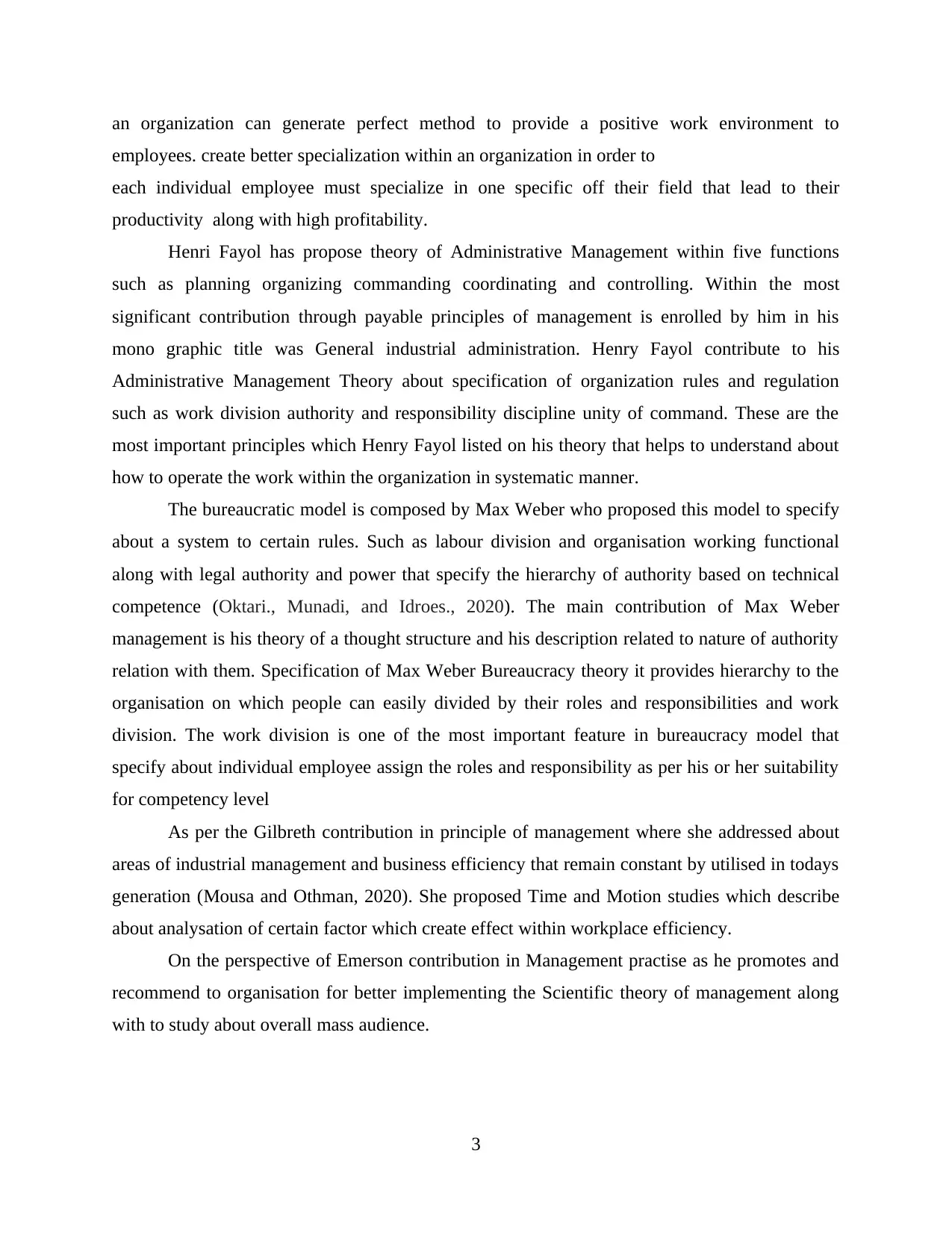
an organization can generate perfect method to provide a positive work environment to
employees. create better specialization within an organization in order to
each individual employee must specialize in one specific off their field that lead to their
productivity along with high profitability.
Henri Fayol has propose theory of Administrative Management within five functions
such as planning organizing commanding coordinating and controlling. Within the most
significant contribution through payable principles of management is enrolled by him in his
mono graphic title was General industrial administration. Henry Fayol contribute to his
Administrative Management Theory about specification of organization rules and regulation
such as work division authority and responsibility discipline unity of command. These are the
most important principles which Henry Fayol listed on his theory that helps to understand about
how to operate the work within the organization in systematic manner.
The bureaucratic model is composed by Max Weber who proposed this model to specify
about a system to certain rules. Such as labour division and organisation working functional
along with legal authority and power that specify the hierarchy of authority based on technical
competence (Oktari., Munadi, and Idroes., 2020). The main contribution of Max Weber
management is his theory of a thought structure and his description related to nature of authority
relation with them. Specification of Max Weber Bureaucracy theory it provides hierarchy to the
organisation on which people can easily divided by their roles and responsibilities and work
division. The work division is one of the most important feature in bureaucracy model that
specify about individual employee assign the roles and responsibility as per his or her suitability
for competency level
As per the Gilbreth contribution in principle of management where she addressed about
areas of industrial management and business efficiency that remain constant by utilised in todays
generation (Mousa and Othman, 2020). She proposed Time and Motion studies which describe
about analysation of certain factor which create effect within workplace efficiency.
On the perspective of Emerson contribution in Management practise as he promotes and
recommend to organisation for better implementing the Scientific theory of management along
with to study about overall mass audience.
3
employees. create better specialization within an organization in order to
each individual employee must specialize in one specific off their field that lead to their
productivity along with high profitability.
Henri Fayol has propose theory of Administrative Management within five functions
such as planning organizing commanding coordinating and controlling. Within the most
significant contribution through payable principles of management is enrolled by him in his
mono graphic title was General industrial administration. Henry Fayol contribute to his
Administrative Management Theory about specification of organization rules and regulation
such as work division authority and responsibility discipline unity of command. These are the
most important principles which Henry Fayol listed on his theory that helps to understand about
how to operate the work within the organization in systematic manner.
The bureaucratic model is composed by Max Weber who proposed this model to specify
about a system to certain rules. Such as labour division and organisation working functional
along with legal authority and power that specify the hierarchy of authority based on technical
competence (Oktari., Munadi, and Idroes., 2020). The main contribution of Max Weber
management is his theory of a thought structure and his description related to nature of authority
relation with them. Specification of Max Weber Bureaucracy theory it provides hierarchy to the
organisation on which people can easily divided by their roles and responsibilities and work
division. The work division is one of the most important feature in bureaucracy model that
specify about individual employee assign the roles and responsibility as per his or her suitability
for competency level
As per the Gilbreth contribution in principle of management where she addressed about
areas of industrial management and business efficiency that remain constant by utilised in todays
generation (Mousa and Othman, 2020). She proposed Time and Motion studies which describe
about analysation of certain factor which create effect within workplace efficiency.
On the perspective of Emerson contribution in Management practise as he promotes and
recommend to organisation for better implementing the Scientific theory of management along
with to study about overall mass audience.
3
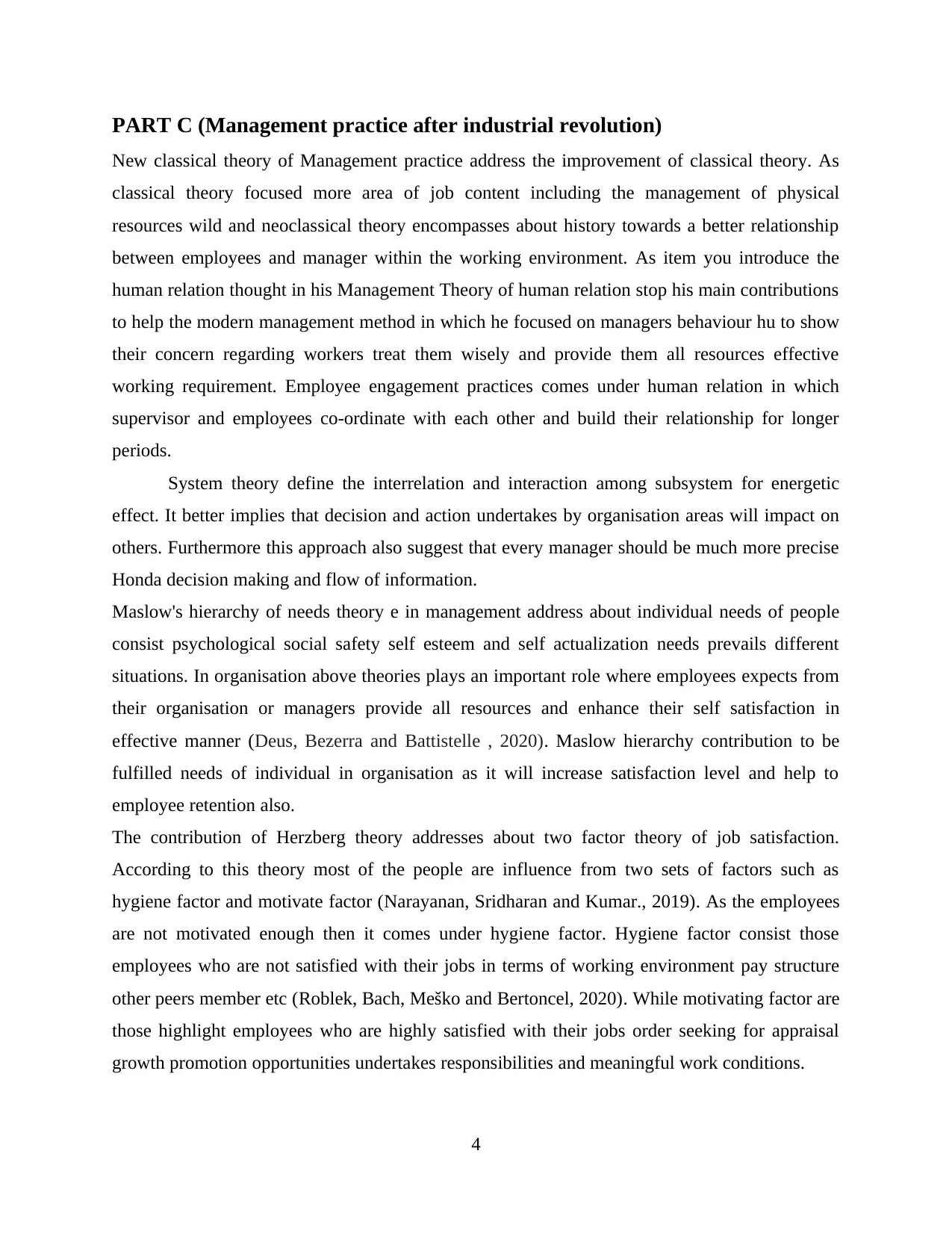
PART C (Management practice after industrial revolution)
New classical theory of Management practice address the improvement of classical theory. As
classical theory focused more area of job content including the management of physical
resources wild and neoclassical theory encompasses about history towards a better relationship
between employees and manager within the working environment. As item you introduce the
human relation thought in his Management Theory of human relation stop his main contributions
to help the modern management method in which he focused on managers behaviour hu to show
their concern regarding workers treat them wisely and provide them all resources effective
working requirement. Employee engagement practices comes under human relation in which
supervisor and employees co-ordinate with each other and build their relationship for longer
periods.
System theory define the interrelation and interaction among subsystem for energetic
effect. It better implies that decision and action undertakes by organisation areas will impact on
others. Furthermore this approach also suggest that every manager should be much more precise
Honda decision making and flow of information.
Maslow's hierarchy of needs theory e in management address about individual needs of people
consist psychological social safety self esteem and self actualization needs prevails different
situations. In organisation above theories plays an important role where employees expects from
their organisation or managers provide all resources and enhance their self satisfaction in
effective manner (Deus, Bezerra and Battistelle , 2020). Maslow hierarchy contribution to be
fulfilled needs of individual in organisation as it will increase satisfaction level and help to
employee retention also.
The contribution of Herzberg theory addresses about two factor theory of job satisfaction.
According to this theory most of the people are influence from two sets of factors such as
hygiene factor and motivate factor (Narayanan, Sridharan and Kumar., 2019). As the employees
are not motivated enough then it comes under hygiene factor. Hygiene factor consist those
employees who are not satisfied with their jobs in terms of working environment pay structure
other peers member etc (Roblek, Bach, Meško and Bertoncel, 2020). While motivating factor are
those highlight employees who are highly satisfied with their jobs order seeking for appraisal
growth promotion opportunities undertakes responsibilities and meaningful work conditions.
4
New classical theory of Management practice address the improvement of classical theory. As
classical theory focused more area of job content including the management of physical
resources wild and neoclassical theory encompasses about history towards a better relationship
between employees and manager within the working environment. As item you introduce the
human relation thought in his Management Theory of human relation stop his main contributions
to help the modern management method in which he focused on managers behaviour hu to show
their concern regarding workers treat them wisely and provide them all resources effective
working requirement. Employee engagement practices comes under human relation in which
supervisor and employees co-ordinate with each other and build their relationship for longer
periods.
System theory define the interrelation and interaction among subsystem for energetic
effect. It better implies that decision and action undertakes by organisation areas will impact on
others. Furthermore this approach also suggest that every manager should be much more precise
Honda decision making and flow of information.
Maslow's hierarchy of needs theory e in management address about individual needs of people
consist psychological social safety self esteem and self actualization needs prevails different
situations. In organisation above theories plays an important role where employees expects from
their organisation or managers provide all resources and enhance their self satisfaction in
effective manner (Deus, Bezerra and Battistelle , 2020). Maslow hierarchy contribution to be
fulfilled needs of individual in organisation as it will increase satisfaction level and help to
employee retention also.
The contribution of Herzberg theory addresses about two factor theory of job satisfaction.
According to this theory most of the people are influence from two sets of factors such as
hygiene factor and motivate factor (Narayanan, Sridharan and Kumar., 2019). As the employees
are not motivated enough then it comes under hygiene factor. Hygiene factor consist those
employees who are not satisfied with their jobs in terms of working environment pay structure
other peers member etc (Roblek, Bach, Meško and Bertoncel, 2020). While motivating factor are
those highlight employees who are highly satisfied with their jobs order seeking for appraisal
growth promotion opportunities undertakes responsibilities and meaningful work conditions.
4
⊘ This is a preview!⊘
Do you want full access?
Subscribe today to unlock all pages.

Trusted by 1+ million students worldwide
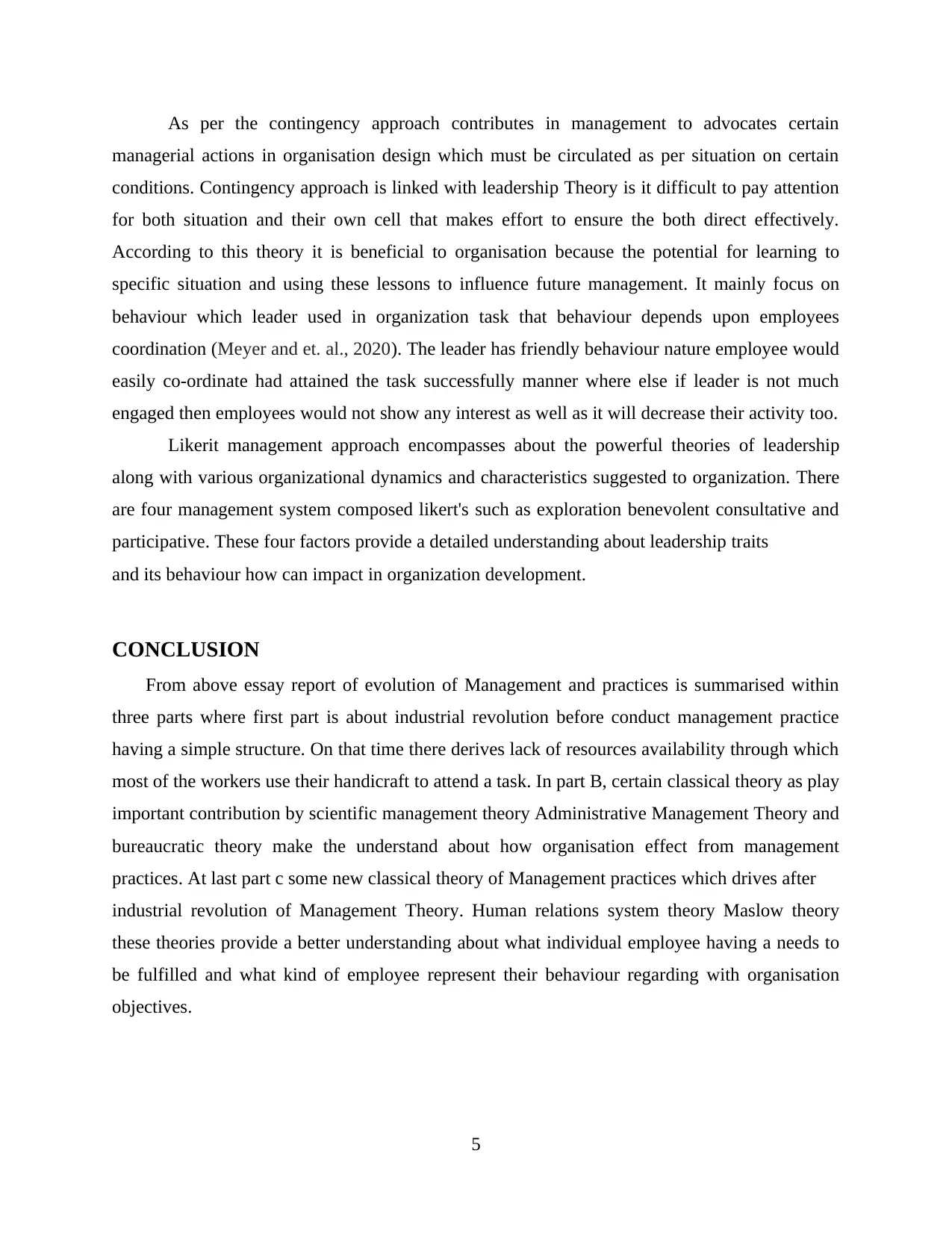
As per the contingency approach contributes in management to advocates certain
managerial actions in organisation design which must be circulated as per situation on certain
conditions. Contingency approach is linked with leadership Theory is it difficult to pay attention
for both situation and their own cell that makes effort to ensure the both direct effectively.
According to this theory it is beneficial to organisation because the potential for learning to
specific situation and using these lessons to influence future management. It mainly focus on
behaviour which leader used in organization task that behaviour depends upon employees
coordination (Meyer and et. al., 2020). The leader has friendly behaviour nature employee would
easily co-ordinate had attained the task successfully manner where else if leader is not much
engaged then employees would not show any interest as well as it will decrease their activity too.
Likerit management approach encompasses about the powerful theories of leadership
along with various organizational dynamics and characteristics suggested to organization. There
are four management system composed likert's such as exploration benevolent consultative and
participative. These four factors provide a detailed understanding about leadership traits
and its behaviour how can impact in organization development.
CONCLUSION
From above essay report of evolution of Management and practices is summarised within
three parts where first part is about industrial revolution before conduct management practice
having a simple structure. On that time there derives lack of resources availability through which
most of the workers use their handicraft to attend a task. In part B, certain classical theory as play
important contribution by scientific management theory Administrative Management Theory and
bureaucratic theory make the understand about how organisation effect from management
practices. At last part c some new classical theory of Management practices which drives after
industrial revolution of Management Theory. Human relations system theory Maslow theory
these theories provide a better understanding about what individual employee having a needs to
be fulfilled and what kind of employee represent their behaviour regarding with organisation
objectives.
5
managerial actions in organisation design which must be circulated as per situation on certain
conditions. Contingency approach is linked with leadership Theory is it difficult to pay attention
for both situation and their own cell that makes effort to ensure the both direct effectively.
According to this theory it is beneficial to organisation because the potential for learning to
specific situation and using these lessons to influence future management. It mainly focus on
behaviour which leader used in organization task that behaviour depends upon employees
coordination (Meyer and et. al., 2020). The leader has friendly behaviour nature employee would
easily co-ordinate had attained the task successfully manner where else if leader is not much
engaged then employees would not show any interest as well as it will decrease their activity too.
Likerit management approach encompasses about the powerful theories of leadership
along with various organizational dynamics and characteristics suggested to organization. There
are four management system composed likert's such as exploration benevolent consultative and
participative. These four factors provide a detailed understanding about leadership traits
and its behaviour how can impact in organization development.
CONCLUSION
From above essay report of evolution of Management and practices is summarised within
three parts where first part is about industrial revolution before conduct management practice
having a simple structure. On that time there derives lack of resources availability through which
most of the workers use their handicraft to attend a task. In part B, certain classical theory as play
important contribution by scientific management theory Administrative Management Theory and
bureaucratic theory make the understand about how organisation effect from management
practices. At last part c some new classical theory of Management practices which drives after
industrial revolution of Management Theory. Human relations system theory Maslow theory
these theories provide a better understanding about what individual employee having a needs to
be fulfilled and what kind of employee represent their behaviour regarding with organisation
objectives.
5
Paraphrase This Document
Need a fresh take? Get an instant paraphrase of this document with our AI Paraphraser

REFERENCES
Books and Journals
Valero, A., 2021. Education and management practices. Oxford Review of Economic Policy,
forthcoming. Valero, A., 2021. Education and management practices. Oxford Review of
Economic Policy, forthcoming.
Korai, M.S, Mahar, R.B. and Yue, D., 2020. Comparison of MSW management practices in
Pakistan and China. Journal of Material Cycles and Waste Management, 22(2), pp.443-
453.
Aschner and et. al., 2020. Persistent poor glycaemic control in individuals with type 2 diabetes in
developing countries: 12 years of real-world evidence of the International Diabetes
Management Practices Study (IDMPS). Diabetologia, 63(4), pp.711-721.
Aboramadan,, Alharazin, H. and Dahleez, K.A., 2020. Human resources management practices
and organizational commitment in higher education: The mediating role of work
engagement. International Journal of Educational Management.
Oktari, R.S., Munadi, K. and Idroes, R., 2020. Knowledge management practices in disaster
management: Systematic review. International Journal of Disaster Risk Reduction,
p.101881.
Deus, R.M., Bezerra, B.S. and Battistelle, R.A.G., 2020. A municipal solid waste indicator for
environmental impact: Assessment and identification of best management
practices. Journal of Cleaner Production, 242, p.118433.
Sciarelli, M., Gheith, M.H. and Tani, M., 2020. The relationship between soft and hard quality
management practices, innovation and organizational performance in higher
education. The TQM Journal.
Meyer and et. al., 2020. HR managers’ talent philosophies: prevalence and relationships with
perceived talent management practices. The International Journal of Human Resource
Management. 31(4), pp.562-588.
Yusoff, Y.M., Nejati, M., Kee, D.M.H. and Amran, A., 2020. Linking green human resource
management practices to environmental performance in hotel industry. Global Business
Review, 21(3), pp.663-680.
6
Books and Journals
Valero, A., 2021. Education and management practices. Oxford Review of Economic Policy,
forthcoming. Valero, A., 2021. Education and management practices. Oxford Review of
Economic Policy, forthcoming.
Korai, M.S, Mahar, R.B. and Yue, D., 2020. Comparison of MSW management practices in
Pakistan and China. Journal of Material Cycles and Waste Management, 22(2), pp.443-
453.
Aschner and et. al., 2020. Persistent poor glycaemic control in individuals with type 2 diabetes in
developing countries: 12 years of real-world evidence of the International Diabetes
Management Practices Study (IDMPS). Diabetologia, 63(4), pp.711-721.
Aboramadan,, Alharazin, H. and Dahleez, K.A., 2020. Human resources management practices
and organizational commitment in higher education: The mediating role of work
engagement. International Journal of Educational Management.
Oktari, R.S., Munadi, K. and Idroes, R., 2020. Knowledge management practices in disaster
management: Systematic review. International Journal of Disaster Risk Reduction,
p.101881.
Deus, R.M., Bezerra, B.S. and Battistelle, R.A.G., 2020. A municipal solid waste indicator for
environmental impact: Assessment and identification of best management
practices. Journal of Cleaner Production, 242, p.118433.
Sciarelli, M., Gheith, M.H. and Tani, M., 2020. The relationship between soft and hard quality
management practices, innovation and organizational performance in higher
education. The TQM Journal.
Meyer and et. al., 2020. HR managers’ talent philosophies: prevalence and relationships with
perceived talent management practices. The International Journal of Human Resource
Management. 31(4), pp.562-588.
Yusoff, Y.M., Nejati, M., Kee, D.M.H. and Amran, A., 2020. Linking green human resource
management practices to environmental performance in hotel industry. Global Business
Review, 21(3), pp.663-680.
6
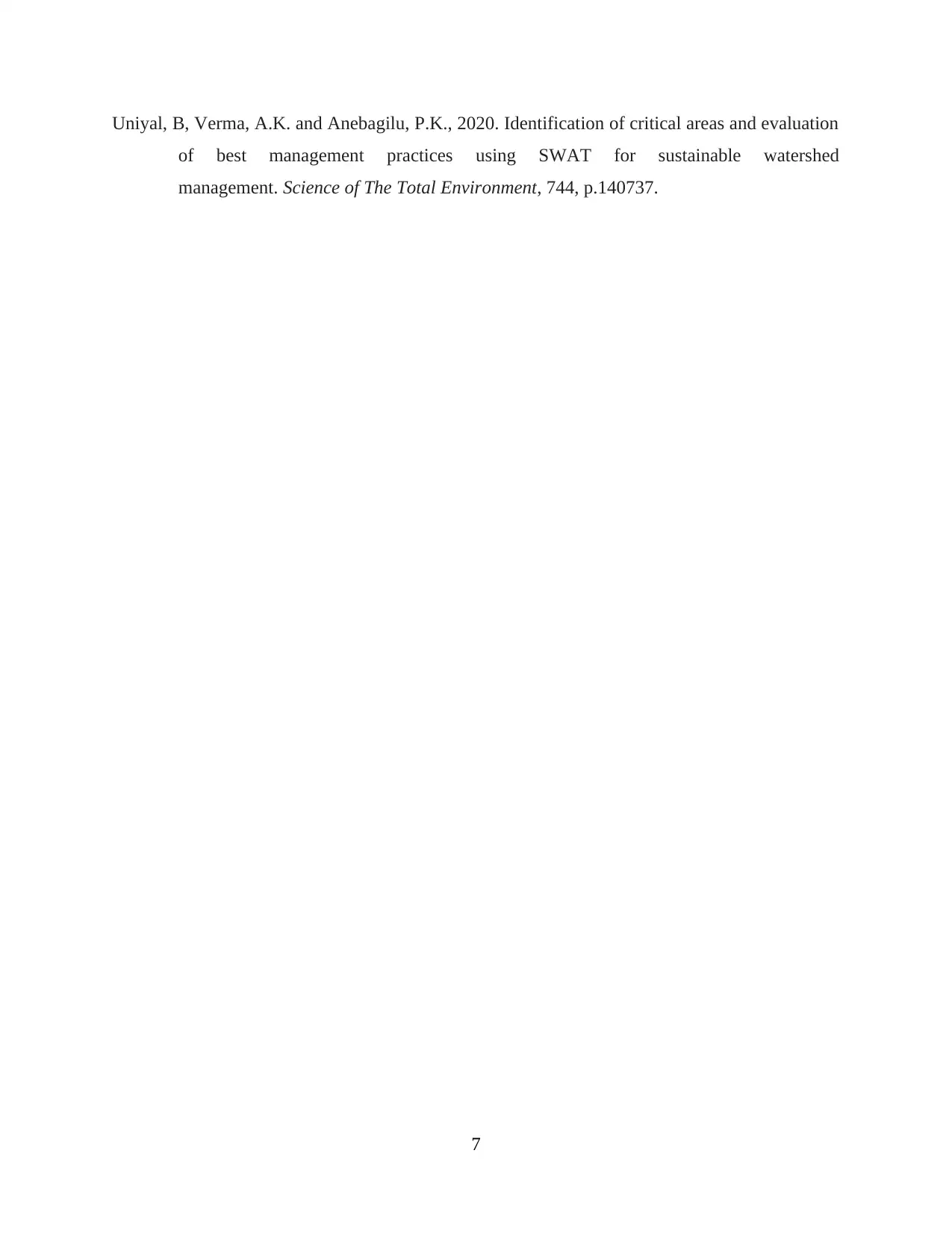
Uniyal, B, Verma, A.K. and Anebagilu, P.K., 2020. Identification of critical areas and evaluation
of best management practices using SWAT for sustainable watershed
management. Science of The Total Environment, 744, p.140737.
7
of best management practices using SWAT for sustainable watershed
management. Science of The Total Environment, 744, p.140737.
7
⊘ This is a preview!⊘
Do you want full access?
Subscribe today to unlock all pages.

Trusted by 1+ million students worldwide
1 out of 9
Related Documents
Your All-in-One AI-Powered Toolkit for Academic Success.
+13062052269
info@desklib.com
Available 24*7 on WhatsApp / Email
![[object Object]](/_next/static/media/star-bottom.7253800d.svg)
Unlock your academic potential
Copyright © 2020–2025 A2Z Services. All Rights Reserved. Developed and managed by ZUCOL.





